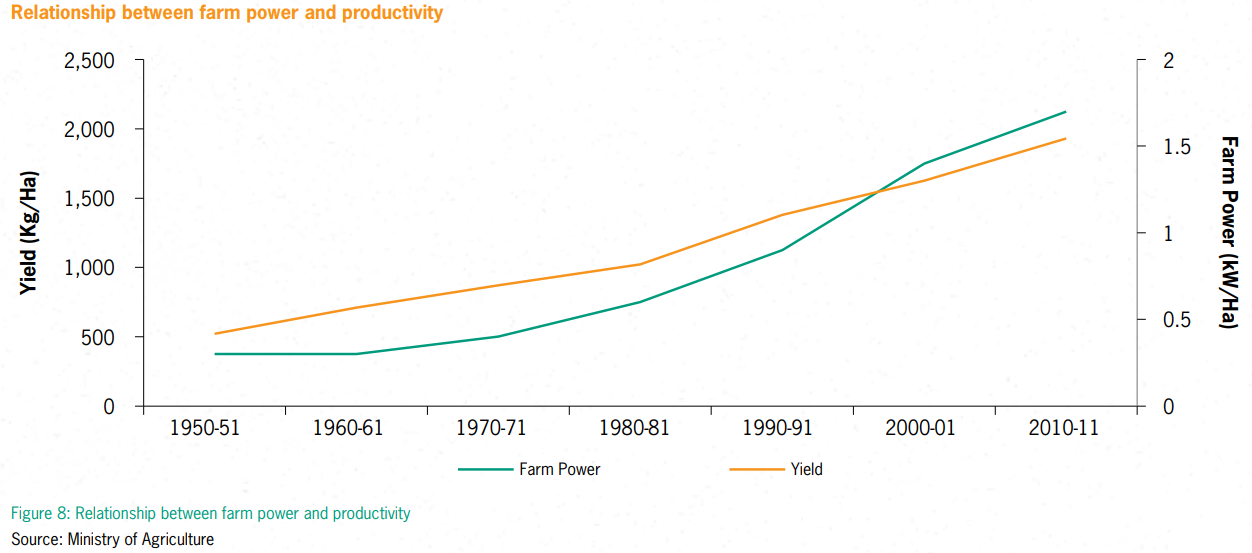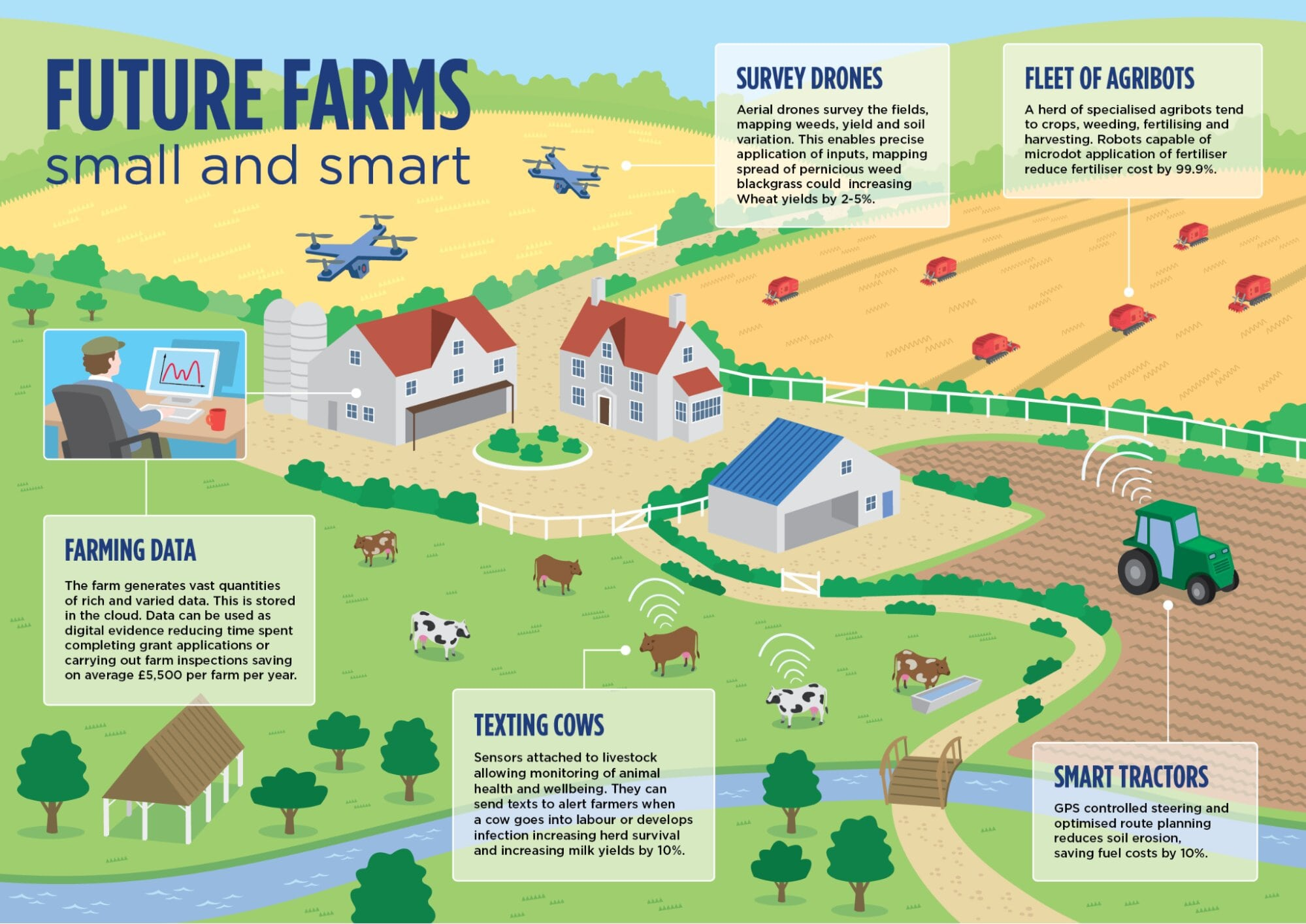Farm Mechanization | 02 Apr 2025
For Prelims: Agriculture, Modified Interest Subvention Scheme, Sub Mission on Agricultural Mechanization (SMAM), Horticultural Crops, ICAR
For Mains: Farm Mechanization in India, Its Status, Advantages and Challenges in Adoption, Key Agricultural initiatives and their status of implementation, Concerts associated with agriculture and Way forward.
Why in News?
India’s farm mechanisation journey, once dominated by tractors, is now witnessing a transformative shift. The focus is moving toward smart machinery, automation, and precision tools to meet modern agricultural demands.
What is Farm Mechanization?
- About: Farm Mechanization involves using machines like harvesters and modern implements to improve productivity, enhance efficiency, and reduce dependence on manual labour in farming operations.
- Emerging Technologies in Farm Mechanization:
- Precision Agriculture: Precisions Agriculture utilizes GPS, IoT, AI, drones, and data analytics to optimize resource use (water, fertilizers, pesticides) based on soil and climate conditions.
- Drones in Agriculture: Drones are used for crop monitoring, pesticide spraying, and yield estimation. India accounts for 22% of global drone imports.
- The Drone Didi Scheme aims to provide 15,000 drones to women SHGs for rental services, boosting mechanization and rural employment.
- Autonomous Machinery: Driverless tractors and robotic harvesters perform tasks like seeding, spraying, and harvesting with minimal human input.
- Agri Robotics and AI: Robots in agriculture have enabled automation in sowing, irrigation, weeding, and harvesting, reducing costs and increasing efficiency.
- Level of Farm Mechanization: In India the overall farm mechanization level in India is around 47%. Punjab and Haryana have 40-45% mechanization, while Northeastern states have negligible adoption.
- Cereal crops like wheat and rice have approx 50-60% mechanization, while horticulture remains less mechanized.
- Globally: Globally, developed nations have over 90% mechanization, while underdeveloped regions, particularly Africa and South Asia, still depend on manual labor. China (60%) and Brazil (75%) lead among developing nations.
What are the Key Significance of Farm Mechanization?
- Input Savings: According to an ICAR report, farm mechanization reduces input costs by saving 15–20% on seeds and fertilizers while increasing cropping intensity by 5–20%.
- Higher Efficiency: It also improves labor efficiency and cuts agricultural operation time by 15–20%, enhancing productivity and sustainability in farming.
- Efficient Land Utilisation: Advanced tilling tools such as rotavators and subsoilers break compacted soil, making hard land arable similarly mechanised irrigation ensures efficient water use, transforming dry or uneven terrain into productive farmland.
What is the Need for Farm Mechanization in India?
- Rising Food Demand: With India's population projected to reach 1.6 billion by 2048 and global food demand set to rise by 60% by 2050 (FAO), limited land, water scarcity, monsoon dependency, and low mechanization pose challenges to sustainable agricultural growth.
- Less Efficient Agriculture: Agriculture supports 46.1% of India’s population but contributes only 16% to GDP (Economic Survey 2024-25), highlighting inefficiencies. Mechanization can bridge this gap by boosting productivity, minimizing post-harvest losses, and ensuring sustainability.
- Labor Shortages and Urbanization: As per the UN, over 50% of India’s population will be urban by 2050, reducing farm labor availability. Rising opportunities in other sectors and schemes like MGNREGA further accelerate workforce migration. Mechanization is essential to sustain agricultural productivity.
- Irrigation Challenges: With only 53% of India’s arable land under irrigation, rainfed agriculture remains vulnerable to climate variability. Mechanization ensures timely sowing and harvesting, enhancing efficiency and reducing crop losses in water-stressed regions.
Global Trends in Farm Mechanisation
- Canada and the US: They have 95% mechanization, with large capital investments in tractors, harvesters, and tillage equipment. In the USA, a farmer now feeds 144 people, up from 26 in 1960. Government support includes low-interest loans, direct subsidies, and price supports.
- France: It has 99% mechanization, with 680,000 highly mechanized farms and an agricultural equipment market worth Euro 6.3 billion. Farmers receive EU subsidies covering 50% of their income, supporting exports and machinery imports.
- Japan: It has high mechanization, with 7 HP tractor power per hectare, comparable to the USA and France. It offers subsidies and high import tariffs to protect domestic farming.
What are the Challenges in Farm Mechanization in India?
- Small and Fragmented Land Holdings: With an average farm size of 1.16 hectares in India (compared to 14 ha in the EU and 170 ha in the US), mechanization remains economically non-viable for small farmers.
- Lack of machinery for small, fragmented farms limits mechanisation.
- Small farms (<2 ha) use power tillers; medium farms (2–10 ha) use 30–50 HP tractors and rotavators; large farms (>10 ha) adopt advanced tools like combine harvesters and laser land levelers.
- Financial Constraints: Farm machineries are expensive, and small farmers struggle to afford it due to limited financial access. Although 90% of tractors are financed, strict loan criteria and high costs make mechanization difficult.
- Poor Equipment Quality: Indian farmers have limited access to advanced machinery, and much of the equipment available is of substandard quality, leading to high operational costs and inefficiency.
- Regional Disparities: Hill agriculture (20% of cultivated land) and remote areas have low mechanization due to terrain challenges, lack of suitable equipment, and weak policy support.
Government Initiatives to Promote Farm Mechanization
Way Forward
- Land Consolidation & Custom Hiring: Encourage land consolidation for efficient mechanization and strengthen Custom Hiring Centers (CHCs) to provide costly machinery like combine harvesters and rice transplanters to small farmers.
- Technology & Financial Access: Ensure subsidies, low-interest credit, and tax incentives for farm machinery adoption while establishing farm machinery banks in low-mechanization regions.
- R&D, Standardization & Training: Promote farmer-industry collaboration, enforce quality standards & testing, and conduct training programs for efficient machinery use and maintenance.
- Inclusive Mechanization: Develop specialized machinery for hilly, rainfed, and horticultural farming to extend mechanization benefits across all regions.
|
Drishti Mains Question: Discuss the challenges in farm mechanization in India and evaluate the government initiatives taken to promote it. |
UPSC Civil Services Examination, Previous Year Question (PYQ)
Prelims
Q. In the context of India’s preparation for Climate -Smart Agriculture, consider the following statements:
- The ‘Climate-Smart Village’ approach in India is a part of a project led by the Climate Change, Agriculture and Food Security (CCAFS), an international research programme.
- The project of CCAFS is carried out under Consultative Group on International Agricultural Research (CGIAR) headquartered in France.
- The International Crops Research Institute for the Semi-Arid Tropics (ICRISAT) in India is one of the CGIAR’s research centres.
Which of the statements given above are correct?
(a) 1 and 2 only
(b) 2 and 3 only
(c) 1 and 3 only
(d) 1, 2 and 3
Ans: (d)
Q. In India, which of the following can be considered as public investment in agriculture? (2020)
- Fixing Minimum Support Price for agricultural produce of all crops
- Computerization of Primary Agricultural Credit Societies
- Social Capital development
- Free electricity supply to farmers
- Waiver of agricultural loans by the banking system
- Setting up of cold storage facilities by the governments
Select the correct answer using the code given below:
(a) 1, 2 and 5 only
(b) 1, 3, 4 and 5 only
(c) 2, 3 and 6 only
(d) 1, 2, 3, 4, 5 and 6
Ans: (c)
Mains
Q. Explain various types of revolutions, took place in Agriculture after Independence in India. How have these revolutions helped in poverty alleviation and food security in India? (2017)
Q. Given the vulnerability of Indian agriculture to vagaries of nature, discuss the need for crop insurance and bring out the salient features of the Pradhan Mantri Fasal Bima Yojana (PMFBY). (2016)


